
Alexander Martin Lippisch (1894 - 1976)
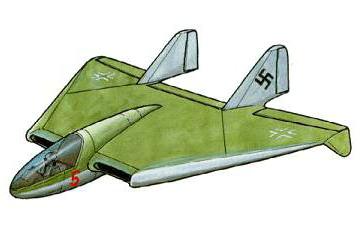 Lippich 13b, 1944 Military Aircraft #023 Luftwaffe Project Aircraft, Delta Publishing
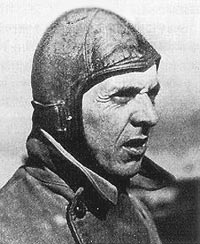 Alexander M. Lippisch
Alexander M. Lippischhttp://www.lib.iastate.edu Alexander Martin Lippisch was born on 2 November 1894 in Munich, Germany, the son of Franz and Clara (Commichau) Lippisch. His father was an artist. Alexander was educated at schools in Berlin and Jena, Germany, and was planning to enter art school when the First World War began. He enlisted in Germany's armed forces in 1915, and served until 1918 as an aerial photographer and mapper. In 1943 he was awarded a doctoral degree at the University of Heidelberg. Lippisch worked for the Dornier Aircraft Company in Friedrichshafen, Germany, as an aerodynamicist from 1918-22.
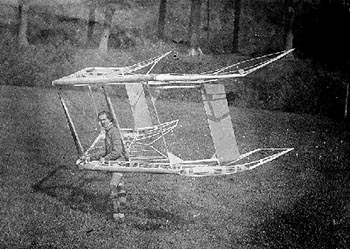 Biplane Tailless Glider, (possibly Lippisch) c.1920 http://www.alexander-schleicher.de
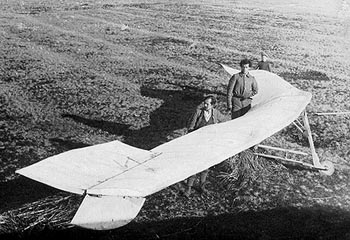 Monoplane Tailless Glider by Lippisch und Espenlaub (E2), c.1923 http://www.alexander-schleicher.de
The Lippisch-Espenlaub (Glider Experiment) E2 was the first of over 50 swept-wing, tailless designs produced by Lippisch over the next three decades. Plates at each wing tip were drooped to provide directional stability. Though this first effort was less than impressive, it at least was a starting point from which Lippisch began serious, systematic development of tailless designs. The Zögling was a simple lightweight glider for basic flight instruction. It was designed to start with rubber ropes, a common way to start a glider in the years short after WWI. It was designed by Alexander Lippisch who became famous by his design Messerschmitt Me 163 Komet, a rocket drive flying wing.
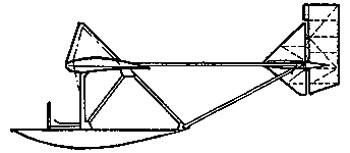 Stamer Lippisch Zögling Schulsegelflugzeug, 1926 http://www.luftfahrtmuseum.com
From 1933-39 he was in Darmstadt as chief of the technical department of the Deutsche Forschungsanstalt fur Segelflug (DFS). DFS sent him to the Messerschmitt Company in 1939, to head a department to develop a rocket fighter for the Air Ministry. From 1943-45 he served as director of research for the Aeronautical Research Institute in Vienna, Austria. He came to the United States in January 1946 as a part of the Operation Paper Clip program administered by the United States Department of Defense. He was stationed at Wright Field in Dayton, Ohio, where he stayed until December 1946 when his family joined him. He worked for the Naval Air Materiel Center in Philadelphia, Pennsylvania, from 1946-50. Lippisch and his family received United States citizenship in 1956. In 1950 Lippisch accepted employment at Collins Radio Company in Cedar Rapids, Iowa, where he was director of the aeronautical division until 1964. One of his first projects at Collins was the design of a high-speed smoke tunnel. Lippisch's work on smoke tunnel flow visualization led to a thirteen part television series in 1955, entitled "The Secret of Flight". The series addressed the amateur viewer, demonstrating the principle of flight through the use of simple models and a smoke wind tunnel. A believer in the importance of a broad education, Lippisch gave many lectures on the significance and the history of flight. He also worked on remote powered vehicles which led to his concept of the Aerodyne. This wingless aircraft was suspended solely by the thrust of its engines and was capable of vertical takeoff and landing. The Aerodyne project was discontinued in 1960, at which time Lippisch became the director of the hydrodynamic laboratory at Collins. He designed a high speed boat which performed very well up to a certain speed, but beyond that point the aerodynamic forces lifted the bow too much. This triggered his interest, and he proposed a boat whose hull would lift out of the water by means of short airplane type wings. This idea was utilized in the aerofoil boat, which was a seaplane that flew efficiently near the ground or water surface. It was powered by a conventional aircraft propeller and was capable of flying far from the ground like a regular airplane. The first full scale aerofoil boat was the Collin X-112. It was first flown in 1965. Lippisch retired from Collins Radio Company in 1964. He underwent lung surgery and upon recovery found himself desiring to continue his work in aircraft design. He consulted for several United States and German companies on the designs of Aerodynes, Aeroskimmers, and Aerofoil boats. In the mid 1920's a friend sent Lippisch a flying seed of a tropical plant . This seed was essentially an arrow shaped wing, and as others had done before him, Lippisch based his tailless arrow shaped aircraft on this example from nature. A private sponsor saw one of these designs and thought it would be possible to build a large version of this type for use as a trans-oceanic transport. However, Lippisch felt that the wing near the body should be thicker so that it could be utilized for additional storage. Lippisch decided that this would only be possible by making the wing near the body longer, and this is how he arrived at the delta shaped wing.
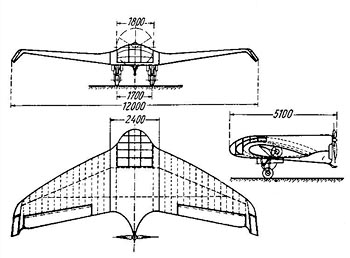 DFS40 Delta V Download a 750pixel image
His first motorized delta wing flew in 1931. Lippisch continued his work with the delta wing during his time as director of the Aviation Research Institute in Vienna, Austria. His team worked on delta wing airplanes that were designed to accommodate a variety of new engines, such as the turbojet and ramjet engines.
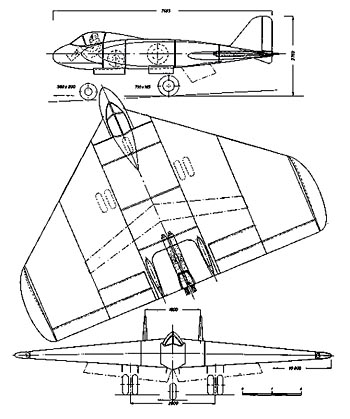 L_P11 Delta V Download a 500pixel image
Alexander M. Lippisch died 11 February 1976 in Cedar Rapids, Iowa, of a heart and lung ailment.
Alexander Martin Lippisch - 1894 - 1976 Born in Munich, Germany, on 2 November 1894. Received his Engineering Doctorate degree from Heidelberg University in Physical Sciences. His aviation career plans interrupted by service in the German Army in World War I, he was finally assigned to work with the Zeppelin Company in 1918. The early post-war years, devoted to theoretical studies and experiments with advanced and unique approaches to high-speed aircraft performance, produced his first successful tailless design, a glider, in 1921. Because the designs he proposed were considered radical departures from the norms of aero design of that period, financial support for his work was difficult to acquire, but his great faith and determination finally won out. ...more
Alexander Lippisch As a boy of 14, Lippisch witnessed a flight by Orville Wright in September 1909. He followed the accounts of Dunne's and Etrich's experiments with inherent stability, and after military service during World War I, applied his interest to glider design. His first tailless glider was built in 1921, by Gottlob Espenlaub, the German glider enthusiast who would later collaborate with the Swiss designer Alexander Soldenhoff on his designs The Lippisch-Espenlaub E2 was the first of over 50 swept-wing, tailless designs produced by Lippisch over the next three decades. Though this first effort was less than impressive, it at least was a starting point from which Lippisch began serious, systematic development of tailless designs. In 1924, he was designated Director of the Aeronautical Department of the RhonRossitten-Gesellschaft (RRG, which later became the German Research Institute for Soaring Flight). ...more
Black Powder Solid Propellants which in part says... Automobile manufacturer Fritz von Opel piloted his own rocket glider, Opel Rak.2, in tests near Frankfurt on 30 September 1928. Its 16 rockets, each producing 50 pounds of thrust, were build by Friedrich Sander a pyrotechnics specialist. The propulsion system combining high-thrust, fast-burning powder rockets for initial acceleration with lower-thrust, slower-burning rockets to sustain velocity. Opel approached Alexander M. Lippisch, a young designer working at the Rhon-Rossitten-Gesellschaft, who had already displayed a penchant for the unorthodox in airplane configuration, with the proposal that he, too, design a glider for rocket power. Max Valier and Alexander Sander also succeeded in arousing enthusiasm for rocket propulsion in a twenty- seven-year-old aircraft designer, Gottlop Espenlaub. His E 15 tail-less design was of interest as a rocketplane. On 11 June, Fritz Stamer effected the first rocket- propelled flight in Lippish's glider. The glider had been dubbed Ente, or Duck. That lead later to the Lippish's Komet - the Messerschmitt Me 163, liquid rocket manned interceptor.
Rudolf "Pitz" Opitz Rudolf "Pitz" Opitz is one of Germany's most famous test pilots. Because of post-World War I aviation restrictions, he began his flying career in gliders. Born in 1910, he built his own glider in 1934 and soon was an instructor at Germany's famous Wasserkuppe flying school. Three years later he became involved in test flying and piloted many of Alexander Lippisch's glider and tailless aircraft. ...more
Testors 1/48 Me-163 Komet
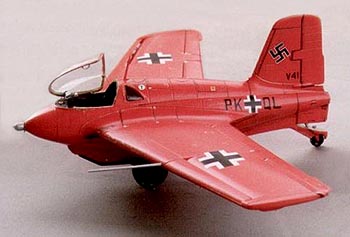 Testors 1/48 Me-163 Komet
The Komet began life as a tailless glider, the brainchild of Dr Alexander Lippisch. Lippisch took up the idea in 1920 with very little in the way of experience in tailless airplanes, making it true pioneering work. The first manned flight of a tailless glider was made in 1929 when Günther Groenhoff flew the all-wing glider, named "Storch" (Stork), immediately after Lippisch's firstborn son had been baptized "Hangwind". In 1928-29 this design had matured to become the "Storch IV", a tailless sailplane and the "Storch V", a motor glider with a 2-cylinder 8 horsepower motor. This latter design had such good flying characteristics that Lippisch presented it to government representatives and the press at Tempelhof Airfield, Berlin. The pilot was Groenhoff. He was later killed in a separate glider accident in the 1932 Rhon competition. Work continued and the predecessor of the Me 163, the DFS 39 (DFS- German Research Institute for Glider Flight), in the hands of Groenhoff's successor, Heini Dittmar proved the aircraft to be a good reliable plane for courier and overland flights. A 75-HP Pobjoy motor powered this aircraft. In 1937 Lippisch received news that shocked him when the Reich Air Ministry's research office issued a contract for a second prototype of DFS 39 with a slightly changed fuselage to allow the installation of a "special power plant". This unit was a liquid-fuel rocket being built by Hellmuth Walter at Kiel. This power plant had 750 kp of thrust and an exhaust gas temperature of 800 degrees Celsius. (The Me 163B's engine had an exhaust temperature of 2000 degrees Celsius. This aircraft was designated DFS 194 and the development was conducted at the Messerschmitt works in Augsburg. The construction of the world's first rocket powered, combat-ready, airplane had begun. On October, 1941 with Heini Dittmar at the controls of the rebuilt DFS 194, now a Me 163A (V3), crossed the 1000 kph barrier for the first time.
Links
Lippisch Nurflugels Lippisch P.13a (DM-1)
www.schifferbooks.comAlexander Lippisch http://www.lippischdesign.com
Alexander Lippisch
|
© Copyright 1999-2002 CTIE - All Rights Reserved - Caution |